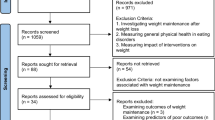Abstract
Girls and women with type 1 diabetes have increased rates of disturbed eating behaviors and clinically significant eating disorders than their nondiabetic peers. Type 1 diabetes is strongly associated with several empirically supported eating disorder risk factors (eg, higher body mass index, increased body weight and shape dissatisfaction, low self-esteem and depression, and dietary restraint). It may be that specific aspects of diabetes treatment increase the risk for developing disordered eating. Disturbed eating behaviors and clinical eating disorders predispose women with diabetes to many complex medical risks and increase risk of morbidity and mortality. For this reason, it is critical that diabetes clinicians understand more about eating disorders to improve the likelihood of early risk detection and access to appropriate treatment. This article presents a review of the current scientific literature on eating disturbances in type 1 diabetes and synthesizes the existent findings into recommendations for screening and treatment.
Similar content being viewed by others
References and Recommended Reading
Colton P, Olmsted M, Daneman D, et al.: Disturbed eating behavior and eating disorders in preteen and early teenage girls with type 1 diabetes: a case-controlled study. Diabetes Care 2004, 27:1654–1659.
Olmsted MP, Colton PA, Daneman D, et al.: Prediction of the onset of disturbed eating behavior in adolescent girls with type 1 diabetes. Diabetes Care 2008, 31:1978–1982.
Peveler RC, Bryden KS, Neil HA, et al.: The relationship of disordered eating habits and attitudes to clinical outcomes in young adult females with type 1 diabetes. Diabetes Care 2005, 28:84–88.
Jones JM, Lawson ML, Daneman D, et al.: Eating disorders in adolescent females with and without type 1 diabetes: cross sectional study. BMJ 2000, 320:1563–1566.
Cooper Z: The development and maintenance of eating disorders. In Eating Disorders and Obesity: A Comprehensive Handbook. Edited by Brownell K, Fairburn CG. New York: Guilford Press; 1995:199–206.
Striegel-Moore RH, Bulik CM: Risk factors for eating disorders. Am Psychol 2007, 62:181–198.
De Groot M, Anderson R, Freedland KE, et al.: Association of depression and diabetes complications: a meta-analysis. Psychosom Med 2001, 63:619–630.
Domargard A, Sarnblad S, Kroon M, et al.: Increased prevalence of overweight in adolescent girls with type 1 diabetes mellitus. Acta Paediatr 1999, 88:1223–1228.
The effect of intensive treatment of diabetes on the development and progression of long-term complications in insulin-dependent diabetes mellitus. The Diabetes Control and Complications Trial Research Group [no authors listed]. N Engl J Med 1993, 329:977–986.
Weight gain associated with intensive therapy in the diabetes control and complications trial. The DCCT Research Group [no authors listed]. Diabetes Care 1988, 11:567–573.
Influence of intensive diabetes treatment on body weight and composition of adults with type 1 diabetes in the Diabetes Control and Complications Trial [no authors listed]. Diabetes Care 2001, 24:1711–1721.
Thompson CJ, Cummings JF, Chalmers J, et al.: How have patients reacted to the implications of the DCCT? Diabetes Care 1996, 19:876–879.
Daneman D, Olmsted M, Rydall A, et al.: Eating disorders in young women with type 1 diabetes. Prevalence, problems and prevention. Horm Res 1998, 50:79–86.
Colton PA, Olmsted MP, Daneman D, et al.: Natural history and predictors of disturbed eating behaviour in girls with type 1 diabetes. Diabet Med 2007, 24:424–429.
Goebel-Fabbri AE, Fikkan J, Connell A, et al.: Identification and treatment of eating disorders in women with type 1 diabetes mellitus. Treat Endocrinol 2002, 1:155–162.
American Psychiatric Association, ed: Diagnostic and Statistical Manual of Mental Disorders DSM IV. Washington, DC: American Psychiatric Association; 1994.
Kahn CR, ed: Joslin’s Diabetes Mellitus. Malvern, PA: Lea & Febiger; 1994.
Polonsky WH, Anderson BJ, Lohrer PA, et al.: Insulin omission in women with IDDM. Diabetes Care 1994, 17:1178–1185.
Rydall AC, Rodin GM, Olmsted MP, et al.: Disordered eating behavior and microvascular complications in young women with insulin-dependent diabetes mellitus. N Engl J Med 1997, 336:1849–1854.
Bryden KS, Neil A, Mayou RA, et al.: Eating habits, body weight, and insulin misuse. A longitudinal study of teenagers and young adults with type 1 diabetes. Diabetes Care 1999, 22:1956–1960.
Verrotti A, Catino M, De Luca FA, et al.: Eating disorders in adolescents with type 1 diabetes mellitus. Acta Diabetol 1999, 36:21–25.
Goebel-Fabbri AE, Franko DL, Pearson K, et al.: Insulin restriction and associated morbidity and mortality in women with type 1 diabetes. Diabetes Care 2008, 31:415–419.
Nansel TR, Anderson BJ, Laffel LM, et al.: A multisite trial of a clinic-integrated intervention for promoting family management of pediatric type 1 diabetes: feasibility and design. Pediatr Diabetes 2008 Aug 20 (Epub ahead of print).
Mitchell J, Pomeroy C, Adson DE: Managing medical complications. In Handbook for Treatment of Eating Disorders. Edited by Garner D, Garfinkel PE. New York: Guilford Press; 1997:383–393.
Hamdy O, Carver C: The Why WAIT program: improving clinical outcomes through weight management in type 2 diabetes. Curr Diab Rep 2008, 8:413–420.
Bantle JP, Wylie-Rosett J, Albright AL, et al.: Nutrition recommendations and interventions for diabetes: a position statement of the American Diabetes Association. Diabetes Care 2008, 31(Suppl 1):S61–S78.
Wolpert HA, Anderson BJ: Metabolic control matters: why is the message lost in the translation? The need for realistic goalsetting in diabetes care. Diabetes Care 2001, 24:1301–1303.
Striegel-Moore R: Etiology of binge eating: a developmental perspective. In Binge Eating: Nature, Assessment, and Treatment. Edited by Fairburn C, Wilson GT. New York: Guilford Press; 1993:144–172.
Polivy J, Herman CP: Dieting and binging: a causal analysis. Am Psychol 1985, 40:193–201.
Lustman PJ, Anderson RJ, Freedland KE, et al.: Depression and poor glycemic control: a meta-analytic review of the literature. Diabetes Care 2000, 23:934–942.
Author information
Authors and Affiliations
Corresponding author
Rights and permissions
About this article
Cite this article
Goebel-Fabbri, A.E. Disturbed eating behaviors and eating disorders in type 1 diabetes: Clinical significance and treatment recommendations. Curr Diab Rep 9, 133–139 (2009). https://doi.org/10.1007/s11892-009-0023-8
Published:
Issue Date:
DOI: https://doi.org/10.1007/s11892-009-0023-8




